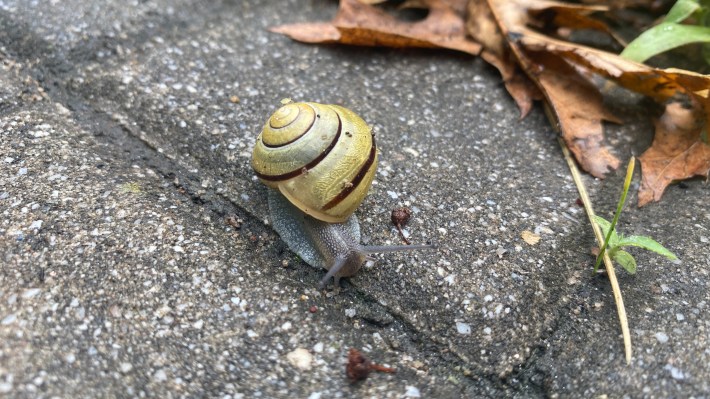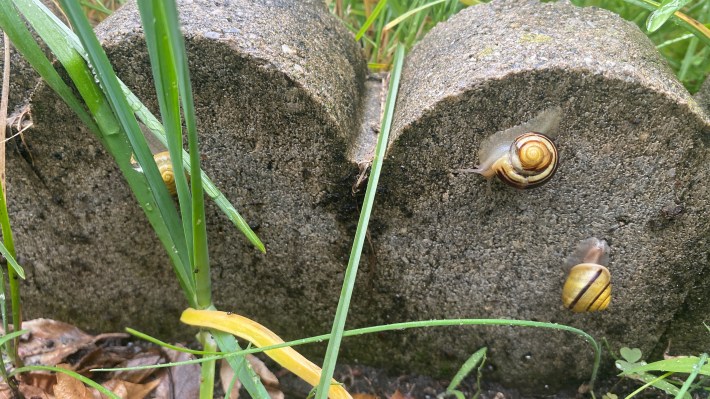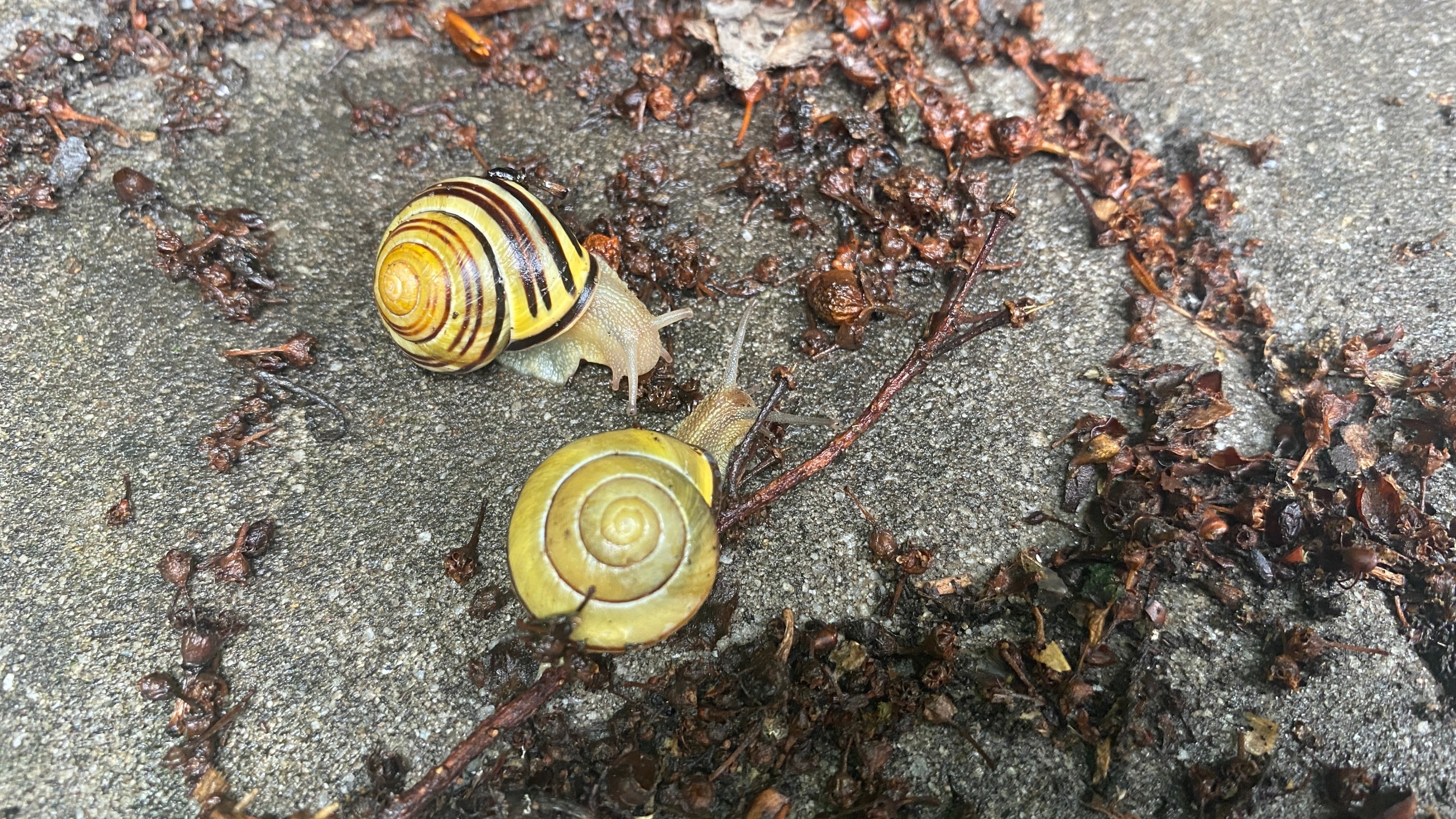Welcome to Meet Our Little Neighbors, an occasional series about the little guys who live among and around us, but rarely get the attention they deserve.
Whenever it rains, all the snails in my backyard abandon their damp hiding spots and slither into the light. They gather in such abundance and in such an array of sizes and colors that I have to remember to walk carefully, eyes fixed on the ground to ensure I don't crush anyone. I learned that lesson in childhood, after a friend and I ran around a rain-soaked parking lot at night amid strange, recurrent crunching noises only to discover dozens of cracked shells and squished snail-flesh studding the asphalt. We were struck with guilt to have been so unaware of our weak spots and our unintentional capacity for destruction.
During the day, it is much easier to sidestep snails. The ones living in my backyard are unmissable. Their striped yellow shells stand out like pats of butter on the gray stones, the green stems, and the brown twigs. They move quickly, likely having not eaten for some time. They have to accomplish all the requisite tasks of snail pleasure, like eating and mating, before the sun dries everything out again.
The species of snails in my backyard are originally from Europe, where they are considerably more famous. The shells of Cepaea nemoralis, the brown-lipped snail, occur in a tremendous variety of colors and patterns. The snails can have yellow, pink, or brown shells and commonly have zero, one, three, or five dark-colored bands coiled in the shell. This range of possible appearances has made the snail an appealing subject of evolutionary genetics research, especially in the snails' European homeland. "Why are there so many types within populations? And what is driving it?" asked Angus Davison, an evolutionary geneticist at the University of Nottingham studying the snails.
The answer? "It's complicated, I suppose," Davison said. Camouflage influences what colors of snails are found in different places, and a yellow snail can more easily blend in a dry, grassy environment. Climate can also have an affect; while brown-shelled snails can overheat in an open environment, they fare better in a dark woodland environment. And predators' preferences play a role, too. "Imagine a young thrush finding its first snail," Davison said. If the thrush's first snail is a tasty yellow snail, the most common color in the area, the bird might seek out yellow snails for the rest of its life, meaning rarer colors may have a better chance of survival. The shell color is not merely ornamental—it is a beautiful shield from predators and the elements. The closest thing I have to a shell is my apartment, which, unlike a snail, I cannot secrete over time in crystallizing layers of calcium carbonate. Instead I have to pay rent.

The color trends of the brown-lipped snails sliming around North America may stem from a founder effect, according to a 1974 study in Society for the Study of Evolution. Unwitting people whisked the unwitting snails away to the United States on multiple occasions, stowed away in the straw that cushioned a shipment of statues from Florence, on the roots of boxwood trees hewn in Holland, or clinging to rose bushes from Ireland. Whatever smattering of snails that happened to cross the seas and start new populations would have created a genetic bottleneck, which may have determined what color shells are most common in North American populations.
Although we are squarely to blame for carrying over Cepea nemoralis from Europe, one of the snail's close relatives, the white-lipped snail Cepea hortensis, somehow crossed the ocean on its own terms about 6,000 years ago—perhaps rafting on a piece of driftwood or stuck on the feather of a migrating bird—making it effectively a native species. "It's the one that was pretty good at traveling," Davison said, adding that the white-lipped snail also inexplicably found its way to Iceland—"not a very hospitable place for these snails." The white-lipped snail's range extends to Long Island, where Davison has been hoping to collect a sample to better understand the population. "I can't get myself out there at the moment," Davison said, "but if you have any readers who live on Long Island who want to help for citizen science, we'd love to hear from them." (Would-be snailers should contact him here.)
Denise Mayer, the curator of malacology at the New York State Museum and the director of the museum’s field research laboratory, receives the occasional call from someone who has spotted a strange or unfamiliar snail around New York. "I'm not, like, the administrator of all things snail," Mayer said. But in May, when she got an email about a swarm of small snails congregating around a bicycle trail, she drove up to see them. She imagined they would be tiny; land snails in New York are often just a few millimeters long, the size of a sand pebble. "You really have to look to see them," Mayer said. But the swarm turned out to be brown-lipped snails—the first ones she'd seen in real life. She collected some to put in a tank and fed them lettuce.

Even though brown-lipped snails are technically invasive in the United States, they are not considered a pest. The species prefers decaying vegetation to fresh plants, and unlike slugs, their bulky shells prevent them from occupying plowed fields. "They don't really cause issue," Mayer said. "Some people might have some leaves of lettuce chewed on in their garden."
I have no garden to speak of—the soil in my neighborhood is a sink for anthropogenic lead—so there is nothing in my backyard the snails could take that I would not freely give. Besides, many of the brown-lipped snails in my backyard have lived there longer than I have. In the wild, "they're probably living somewhere—as long as they're not getting stood on—between three to five years," Davison said. When I eventually move out of this apartment, they will remain. My backyard is more theirs than it is mine.
So I consider it my solemn mission look out for my snail neighbors—not to step on, mistakenly crunch, or otherwise harm my backyard mollusks. It's not always easy! Sometimes I forget, striding out in my backyard with nary a glance toward the cobblestones until I hear a crunch and peek down to see, thankfully, it was just a twig. But it's really the least I can do, as a Tall Giant in this particular scenario. I need only watch my step to mark the difference between life and death for a snail. It is a reminder of how power works, how living with regard for smaller beings can change little in your life but everything in theirs.
I often feel puny as a person, like when a rent hike or layoff reminds me that my housing and healthcare can be taken away in a moment by a landlord or insurance company or lawmaker. I feel puny when I take an empty can of seltzer home from the park so I can recycle it at home and think of how little my own recycling matters in a world where private jets exist. But I know that power can be relative, and even though I probably make no real difference in the world by diligently recycling plastic that will inevitably be burned into dirty fuel, I can make a difference in the worlds where I am big—by sidestepping the snails, by releasing the moths trapped inside my foyer who confused my ceiling light for the moon, and, counterintuitively, by killing this beautiful, invasive lanternfly. I learn to ask myself: Who perceives me as a giant, and how can I help them, or, in the very least, leave them in peace?
At one of my elementary school science fairs, I remember a boy in my class did his experiment on snails—specifically what would happen if you poured salt on them. The presentation was awful, in dullness and cruelty. We all knew what would happen. A snail dying by way of salt was not news to us, nor was it an experiment in any real scientific sense. The outcome was no mystery. Perhaps pouring different brands of salt on a snail would be an experiment, to see which killed the snail the fastest. But who would be served, and who harmed, from that knowledge? "Just asking questions" is not a neutral stance. Maybe there is no such thing as a neutral stance when you have power, and believing yourself to be neutral simply reflects an ignorance, willful or not, of the ways in which your comfort exists at the expense of another. Maybe it is a gift to spend time with a being utterly unlike you, something beautiful and slimy and slow that may be descended from a snail that crossed oceans nestled in a rosebush. We are all here, and there is enough space for all of us.

These days, I find myself envying snails and their immediate access to dormancy. When a snail's environment becomes unlivable—too hot, too cold, too dry—the snails will go dormant, sealing off their body from the world with a little mucus plug. "They'll just stay there until it starts raining," Davison said. "They can sit there for months, absolutely fine." A snail already has everything it needs to stay climate-controlled whereas my unshelled human body requires the clunky trappings of an air conditioning unit. "They can be in some quite extraordinary, apparently hostile conditions in which they can still do quite well," Davison said. "As long as it rains sometimes."
So if the snails can endure it all—the heat, the cold, the dryness, the lead-sprinkled dirt—waiting it out for months until the air is moist and cool enough to emerge to carouse together and drink in the calcium from the concrete by my barbecue, then so can I. After it rains, I sit with the snails and watch them slink around and wonder what concrete tastes like to a snail. And then I go back indoors, inside my own shell.






